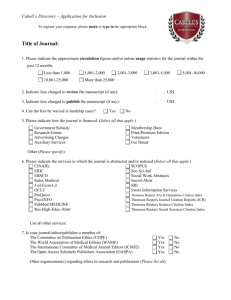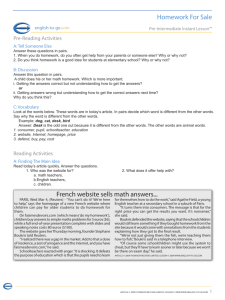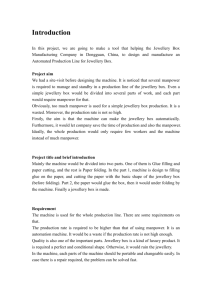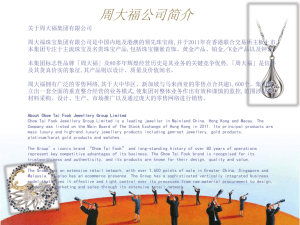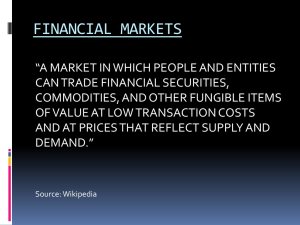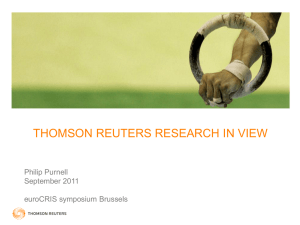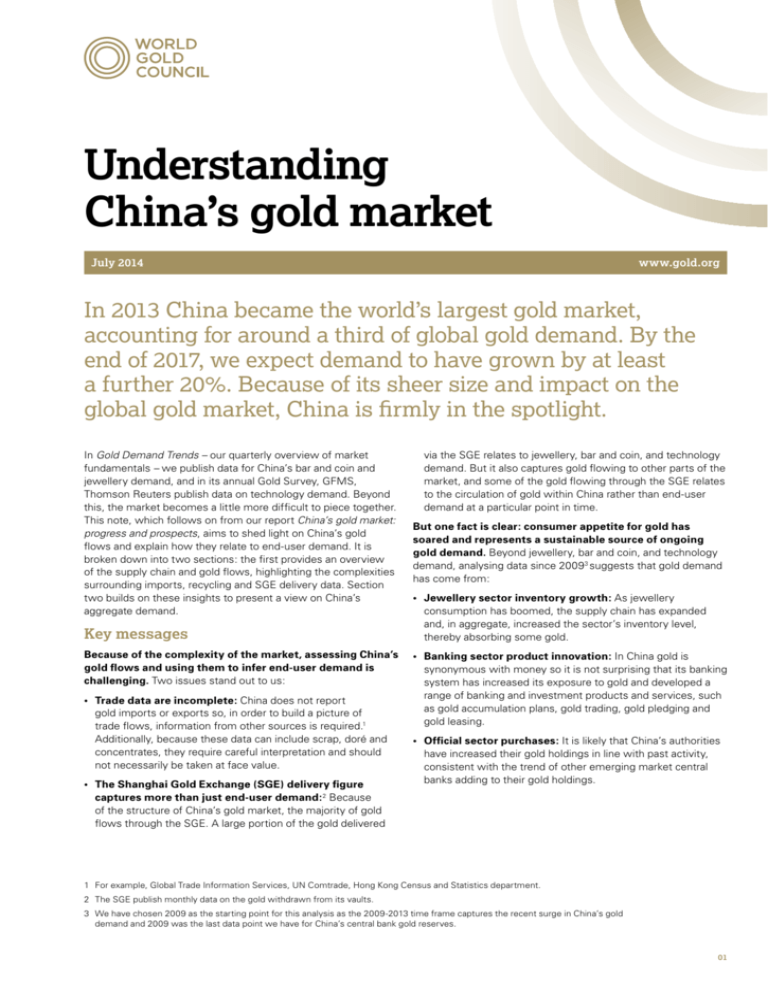
Understanding
China’s gold market
July 2014
www.gold.org
In 2013 China became the world’s largest gold market,
accounting for around a third of global gold demand. By the
end of 2017, we expect demand to have grown by at least
a further 20%. Because of its sheer size and impact on the
global gold market, China is firmly in the spotlight.
In Gold Demand Trends – our quarterly overview of market
fundamentals – we publish data for China’s bar and coin and
jewellery demand, and in its annual Gold Survey, GFMS,
Thomson Reuters publish data on technology demand. Beyond
this, the market becomes a little more difficult to piece together.
This note, which follows on from our report China’s gold market:
progress and prospects, aims to shed light on China’s gold
flows and explain how they relate to end-user demand. It is
broken down into two sections: the first provides an overview
of the supply chain and gold flows, highlighting the complexities
surrounding imports, recycling and SGE delivery data. Section
two builds on these insights to present a view on China’s
aggregate demand.
Key messages
Because of the complexity of the market, assessing China’s
gold flows and using them to infer end-user demand is
challenging. Two issues stand out to us:
• Trade data are incomplete: China does not report
gold imports or exports so, in order to build a picture of
trade flows, information from other sources is required.1
Additionally, because these data can include scrap, doré and
concentrates, they require careful interpretation and should
not necessarily be taken at face value.
• The Shanghai Gold Exchange (SGE) delivery figure
captures more than just end-user demand: 2 Because
of the structure of China’s gold market, the majority of gold
flows through the SGE. A large portion of the gold delivered
via the SGE relates to jewellery, bar and coin, and technology
demand. But it also captures gold flowing to other parts of the
market, and some of the gold flowing through the SGE relates
to the circulation of gold within China rather than end-user
demand at a particular point in time.
But one fact is clear: consumer appetite for gold has
soared and represents a sustainable source of ongoing
gold demand. Beyond jewellery, bar and coin, and technology
demand, analysing data since 2009 3 suggests that gold demand
has come from:
• Jewellery sector inventory growth: As jewellery
consumption has boomed, the supply chain has expanded
and, in aggregate, increased the sector’s inventory level,
thereby absorbing some gold.
• Banking sector product innovation: In China gold is
synonymous with money so it is not surprising that its banking
system has increased its exposure to gold and developed a
range of banking and investment products and services, such
as gold accumulation plans, gold trading, gold pledging and
gold leasing.
• Official sector purchases: It is likely that China’s authorities
have increased their gold holdings in line with past activity,
consistent with the trend of other emerging market central
banks adding to their gold holdings.
1 For example, Global Trade Information Services, UN Comtrade, Hong Kong Census and Statistics department.
2 The SGE publish monthly data on the gold withdrawn from its vaults.
3We have chosen 2009 as the starting point for this analysis as the 2009-2013 time frame captures the recent surge in China’s gold
demand and 2009 was the last data point we have for China’s central bank gold reserves.
01
Section 1: Assessing China’s gold flows
and data
Mapping out China’s gold market
In order to visualise gold flows within the Chinese market,
the schematic below (Figure 1) maps out gold supply from its
various sources, how it flows through the SGE and the sources
of end-user demand. We will consider each in turn.
Supply
• Mine production: Gold produced by China’s fragmented
gold mining industry reaches end-users via the SGE.
There are over 600 domestic mines, many of them small
operations which sell their output to larger producers for
refining.4 Mine output goes to domestic SGE-recognised
refiners and to the Exchange for onward sale.
• Recycling: There are two types of recycled gold:
i) Gold-for-cash and ii) gold-for-gold. At a retail level
consumers can sell gold for cash or, especially in the case of
jewellery, exchange old pieces of gold for new pieces of gold.
It may be that in tonnage terms, gold-for-gold recycling is
similar in size to gold-for-cash recycling: we recently surveyed
1,000 consumers and found that 8% of gold owners had sold
gold-for-cash, while 10% had exchanged gold-for-gold.5
At a wholesale level banks and jewellers may also sell or
exchange gold stock with other suppliers.
A key point to note is that recycled gold-for-cash increases
gold supply, while recycled gold-for-gold increases both
supply and demand, i.e. it increases the turnover of gold but
does not affect the supply-demand balance. Recycling and
demand estimates reported in both Gold Demand Trends and
GFMS, Thomson Reuters’ Gold Surveys exclude exchanged
gold on both the supply and demand side; although it
increases gross measures of supply and demand, the net
impact is neutral. Gold flowing through the SGE, however,
can include both recycled gold-for-cash and gold-for-gold.
Figure 1: Schematic diagram of gold flows in China
Imports
(via Hong Kong and direct to mainland China)
Consignment
Supply
Recycled gold: gold-for-cash
and gold-for-gold
Domestic
mine production
Refineries
Shanghai Gold Exchange
(SGE)
SGE
deliveries
Recycled gold:
gold-for-gold
Round-tripping and
genuine exports to HK
Jewellery manufacturer
with import/export
licience
Gold exchange
Banking
sector
Jewellery
sector
Technology
sector
Official
sector
Exports to rest
of the world
Demand
Recycled gold:
gold-for-cash
Consumer
demand
4 Large gold miners and a number of base-metals producers have their own refineries.
5 Kadence, 1,000 Chinese consumers, Q2 2014.
Market Intelligence | Understanding China’s gold market
02
• Trade data: There are two issues which cloud the picture
of gold flows into China. The first is that data are limited.
Mainland China does not publish its own trade statistics so
analysts rely on other sources, such as trade data from the
Hong Kong Census and Statistics Department. In addition,
there is little publicly available information on direct flows
into mainland China, such as to Shanghai and more recently
Beijing, although this has improved as other countries have
started providing more trade data.6 The second point is that
gold flows are not always pure gold. Trade data includes gold
jewellery, semi-manufactured products, scrap, doré, and
concentrates. Non-bullion gold imports can be mis-labelled
too. Shipments can include other metals recorded under a
gold-related Harmonised System (HS) code.7 So while import
data are very useful, they need careful interpretation and
should not necessarily be taken at face value.
The issue of ‘round-tripping’ is often raised when analysing
imports into China. This is where a stock of gold flows in
a loop between Hong Kong and mainland China to exploit
arbitrage opportunities.8 These arbitrage opportunities can
arise from differences in interest, exchange or tax rates.
This is an interesting part of the market, but mostly serves
to inflate gross trade figures, rather than affecting China’s
end-user demand. Analysing net imports from Hong Kong
to mainland China helps cut through this issue and provides
better guidance on the total supply of gold into mainland
China. As reported in China’s gold market: progress and
prospects and in GFMS, Thomson Reuters’ Gold Survey
2014, ‘round-tripping’ may flow through the SGE and could
be captured in the Exchange’s delivery figures. While this
might happen, we believe there are frictions which would limit
it, not least that the costs associated with processing bars
through the SGE – for example, transaction, transportation,
and insurance fees – would erode some of the arbitrage profit
round-trippers are seeking.
We have purposely excluded smuggling from this schematic.
While gold may be smuggled into the country, it is equally
likely that it is smuggled out. China’s neighbours include India
and Vietnam, two large gold markets with porous borders
and high domestic premiums over the global gold price.
Gold smuggling is especially opaque and beyond the scope
of this analysis, but we have previously commented that
we believe gold smuggled into India in 2013 was around
150-200 tonnes (t), some of which may have come
via China.
• Gold flowing into China does not automatically go to
the SGE: Importing banks will often store gold on
consignment before it is sold on the Exchange, and
Shenzhen-based jewellery manufacturers with the necessary
import/export licences will typically import and export gold
without it going via the SGE.
The SGE plays a key role in China’s gold market.
The SGE – a non-profit membership organisation – is the central
hub through which the vast majority of gold in China flows,
including imports, refined scrap and domestic mine production.9
It also offers favourable tax treatment: gold sold on the
Exchange is not subject to value-added tax (VAT).
Its mandate is broad, including facilitating gold, silver and
platinum trades, organising deliveries, supervising and
monitoring warehouses, collating and distributing market
information and connecting the domestic and international gold
markets. Importantly, gold which has been withdrawn from the
SGE cannot be sold directly back to the Exchange by private
investors or non-SGE members – it first needs to be re-cast into
a new bar. This ensures gold on the Exchange maintains its high
quality, meeting the rigourous standards set by the Exchange.
Because of the SGE’s importance in the Chinese gold market,
its monthly delivery figures are closely watched.
6 For example, in January 2014 the Swiss Federal Council started publishing gold trade data on a country-by-country basis.
7The Harmonised System is an international nomenclature for the classification of products. It allows participating countries to classify traded goods
on a common basis for customs purposes. At the international level, the Harmonised System (HS) for classifying goods is a six-digit code system.
8GFMS, Thomson Reuters estimate round-tripping in 2013 was in excess of 360 tonnes, Gold Survey, 2014
9Not all recycled gold goes through the SGE. In some instances large fabricators may refine and recast gold themselves, without passing it on to a refinery.
Market Intelligence | Understanding China’s gold market
03
Data on the supply of gold to China does not paint a
clear picture...
The supply side of the market can be viewed from a few
angles, including analysing trade flows and domestic supply, or
looking at the SGE’s delivery figures. Estimating total supply10
since 2009 provides a figure of 5,150t. This differs from the
cumulative SGE deliveries figure of 5,811t. What accounts for
this difference?
Given the complexity of the market there could be many
reasons, but the most likely explanation is that the SGE delivery
figure includes the flow of recycled gold-for-gold as well as
gold-for-cash. As explained previously, while recycled gold-forgold will increase supply and demand, the net effect is market
neutral. For this reason, demand and recycling estimates as
reported in Gold Demand Trends and GFMS, Thomson Reuters’
Gold Surveys exclude recycled gold-for-gold. But because the
structure of the Chinese gold market requires refined and recast
recycled gold to be sold through the SGE, it is likely the delivery
figure captures this circulation of recycled gold-for-gold.
...not least because China exports gold.
It is well documented that mainland China is a net importer
of gold. In addition, bullion exports are prohibited. There is,
however, scope for mainland China to export gold in other
forms, for example jewellery or semi-manufactured products,
to destinations other than Hong Kong.
As discussed previously, import and export data should not be
taken at face value; rarely do they provide the complete picture
and often need to be triangulated with other information to gain
a more thorough understanding of their contribution to gold
demand. But they can provide useful insights. For example,
Global Trade Information Services allows us to review the
gold trade balance between mainland China and the rest of
the world.13 These data reveal that since 2009, while mainland
China has been a net importer from Hong Kong, Australia and
Switzerland, it has been a net exporter to Indonesia, Taiwan
and India. That there are gold exports to places other than
Hong Kong is something which should be factored in when
thinking about gold flows in China.
In addition, as will be explained in the following section,
China’s banks have developed an innovative range of banking
and investment products and services, including providing
corporates and individuals the ability to lease gold and pledge
gold as collateral. These transactions can be filtered through the
Exchange and, if the gold is withdrawn, would be captured by
the SGE delivery figure.11 As an indication of how this market
has grown, in April 2014 the SGE reported gold leasing totalled
1,103t in 2013, growing from less than 30t in 2007.12
10 GFMS, Thomson Reuters’ mine production and scrap data + Hong Kong Census net exports + an assessment of direct flows into China.
11For example, ICBC’s customers of its Physical Gold Leasing scheme can trade or withdraw gold via the Shanghai Gold Exchange and Gold Pledging
customers can register a gold pledge via the SGEs member service or at ICBC repurchase outlets.
12 Metals Focus, Precious Metals Weekly, Issue 48.
13 Including HS codes: 710811, 710812, 710813, 710820, 711319, 711890.
Market Intelligence | Understanding China’s gold market
04
Section 2: Assessing China’s end user
demand since 2009
Gold is woven into many parts of Chinese society, so it is not
surprising that demand is spread across many sectors. This
section assesses private (defined as jewellery, bar and coin,
and technology demand), jewellery trade, financial and official
sector demand.
Bar and coin, jewellery and technology demand has
boomed over recent years...
Jewellery, bar and coin, and technology demand account for
around 84% of gold supplied to mainland China’s gold market.14
For a closer look at the estimates that are produced for bar
and coin, jewellery, and technology fabrication demand,15
we will examine two of the most well-known data sources:
GFMS, Thomson Reuters and the China Gold Association16
(CGA) (Chart 1).
The data collection methodology used by GFMS, Thomson
Reuters and the CGA may differ, giving rise to slightly different
estimates. But regardless of the methodology used, the trend is
clear: jewellery, bar and coin and technology demand have seen
significant growth over recent years. That is the key message
that observers of Chinese gold demand have drawn: gold
consumption in China has soared and, as explained in China’s
gold market: progress and prospects, is expected be
at least 20% higher by 2017.
...and as jewellery demand has soared, the jewellery
supply chain has expanded.
As consumers have become wealthier, jewellery demand in
China has increased; between 2009 and 2013 the nominal value
of gold purchased increased from RMB80bn to RMB228bn
(Chart 2). As a result the jewellery sector has expanded.
Chart 1: Gold demand has soared*
Tonnes
1,600
1,400
1,200
1,000
800
600
400
200
0
2009
GFMS, Thomson Reuters
2010
2011
2012
2013
China Gold Association
*Including jewellery, bar and coin, and technology fabrication demand.
Source: China Gold Association; GFMS, Thomson Reuters
14Cumulative GFMS, Thomson Reuters’ demand since 2009 (4,334t) as a percent of cumulative Thomson Reuters’ mine production and scrap data + Hong
Kong Census net exports + an assessment of direct flows into China (5,150t).
15Fabrication is the first transformation of gold bullion into a semi-finished or finished product. Consumption demand is equal to fabrication plus or minus
imports or exports and stocking or de-stocking in the supply chain.
16Established in November 2001 the CGA plays an active role in China’s gold industry. It acts as a bridge between the Chinese government and gold
producers in protecting business interests and providing information, consultancy, co-ordination and intermediary services.
Market Intelligence | Understanding China’s gold market
05
New retail outlets have been rolled out across China’s more
than 600 Tier 3 and Tier 4 cities and there are now over 100,000
jewellery stores. The supply chain feeding the industry has
grown too. Shenzhen, China’s major gold fabrication hub, now
has around 3,600 jewellery corporations and another 5,000
registered self-employed individual jewellers.17
As the supply chain expanded, so did the amount of gold being
demanded at the wholesale level, as each additional retail outlet
or manufacturer held a small level of inventory to meet demand.
As indicative analysis, we have considered the change in gold
inventory at Luk Fook and Chow Sang Sang, two of China’s
largest publicly listed jewellery retailers.18 Assuming all of their
stock by value is gold, their gold inventories increased by about
30t between 2009-2013.
Inventories will, however, include other high-value materials,
such as platinum, silver, diamonds and other gem stones. Some
items in jewellers’ inventories may also include a mark-up. The
sample we have looked at is small – less than 5% of the entire
jewellery industry by value19 – and may not be representative
of the entire industry. It is, however, indicative that as jewellers
expanded, so too did their inventory levels and it is our
judgement that across the industry between 75t to 125t may
have been absorbed in the supply chain since 2009.
Gold as an investment asset and the expanding fabrication
industry has resulted in China’s banking system increasing
the provision of gold-related investment and banking
products.
Gold is synonymous with money in Chinese culture and has
been a preferred form of savings for generations, so it is not
surprising that it has become an increasingly important part of
the financial system. Most large banks in China offer savers
the opportunity to buy gold bars and coins. Agricultural Bank
of China promotes its Chuan Shi Zhi Bao bars, Industrial and
Commercial Bank of China (ICBC) has its Ruyi Gold brand
and the Bank of China has sold bars depicting the animals
representing the Chinese years of the Zodiac.
Inspired by GaveKal Dragonomics research,20 we have analysed
the changes in the amount of precious metals on the balance
sheets of seven of the largest banks in China between 2009
and 2013.
Chart 2: China’s jewellery demand trebled in value between 2009-2013
Tonnes
900
RMBbn
250
800
200
700
600
150
500
400
100
300
200
50
100
0
0
2009
China jewellery demand (tonnes)
2010
2011
2012
2013
China jewellery demand (value, RMBbn, rhs)
Source: GFMS, Thomson Reuters; The London Gold Market Fixing Ltd; Thomson Reuters Datastream; World Gold Council
17 Shenzhen Gold and Jewelry Association.
18Although Luk Fook and Chow Sang Sang are headquartered and listed in Hong Kong, they have a significant presence in mainland China.
19Euromonitor, Jewellery in China, December 2013.
20 China Update, Identity of mystery gold buyer revealed, April 2014.
Market Intelligence | Understanding China’s gold market
06
Over this period the value of precious metals on banks’ balance
sheets grew. In the sample we examined the total value
increased by RMB 268bn, mostly driven by expanding precious
metals business lines (Chart 3).
How much of this is gold? If the entire amount were gold,
banks would hold around 1,455t on their balance sheets, an
increase of around 1,150t over this period, with the largest spurt
of growth coming in between 2012 and 2013. It is, however,
unlikely to be all gold. We know, for example, that since 2009
silver has also become popular with investors. Using the ratio
of SGE and Shanghai Futures Exchange trading values of gold
and silver as a proxy for the split of precious metals exposure
on banks’ balance sheets, the amount of gold could be closer
to 500t and the growth would have been 200t since 2009.
It is also worth noting that gold held on banks’ balance sheets
need not represent physical gold based in China; it could include
gold positions held in the London over-the-counter market or
positions in the paper market.21
These methods of estimating the amount of gold on China’s
banks’ balance sheets are fallible, but given the lack of granular
information, they are helpful in providing a range estimate.
It is our judgement that the amount of gold on China’s banks’
balance sheets has increased between 400t and 600t
since 2009.
The next question is how is gold used in China’s banking
system? Following the authorities decision allowing private
investors to buy gold bullion in 2004, the Chinese banking
industry has developed the supply side infrastructure to support
gold demand and created an innovative range of gold products.
• Inventory: Banks with import licences are responsible for
most of the imports into China, and they use their balance
sheets to fund a certain level of inventory to meet demand.
• Gold Accumulation Plans: We know that banks have been
active in developing gold-related products to tap into Chinese
investors’ appetite for gold, the most prominent example
being Gold Accumulation Plans (GAP). ICBC launched China’s
first GAP in 2010, and over recent years others have followed
suit. Four other banks now offer gold accumulation plans:
Bank of China, Agricultural Bank of China, Guangfa, and
Bank of Communications.
Data on the tonnage accounted for by GAP accounts are
not publicly available, but it is our judgement that they could
hold between 100t and 200t. These data are not captured in
GFMS, Thomson Reuters estimates of Chinese investment
demand. Rather, they fall into its Net Balance estimate, or
the OTC investment and stock flows estimate as reported in
Gold Demand Trends.
Chart 3: China’s banks have innovated and gold exposure has increased
RMBbn
250
200
150
100
50
0
Bank of China
2009
ICBC
China Construction Bank
Other*
2013
*Other comprises Agricultural Bank of China, Pudong Development Bank, Ping An Bank and China Merchants Bank.
Source: Bloomberg; Company Reports; Gavekal Dragonomics; The London Gold Market Fixing Ltd; World Gold Council
21For example, page 57 of Agricultural Bank of China’s 2013 annual report states that it “fulfilled the demand of customers... [on the]... Shanghai Gold
Exchange, Shanghai Futures Exchange and London precious metals market.”
Market Intelligence | Understanding China’s gold market
07
• Structured products: Banks’ treasury departments have
developed structured products related to physical gold.
These have been marketed to both high net worth investors
and companies.22
• Gold leasing: Banks also lend gold. The borrowers tend to be
fabricators, as borrowing ensures they have immediate access
to gold to meet demand and it is an effective way for firms to
leverage banks’ balance sheets to fund their businesses.
• Gold trading: Most of China’s banks trade gold on a
proprietary basis on the SGE and, via Agency Gold Trading,
banks offer access to the SGE trading platform to retail
investors and fabricators.
Importantly, this facility is not open to all customers.
Prospective borrowers are typically a business in the gold
industry, such as a jewellery fabricator. The rules identifying
eligible borrowers were tightened in 2013 as the authorities
looked to rein in credit expansion.
• Custody: Banks vault gold on a custodian basis for customers
with physical gold holdings, including fabricators and
investors.
• Gold as collateral: Banks take gold as collateral for loans.
This service is designed to increase the liquidity of precious
metals. Gold, platinum and silver are all eligible to be pledged
as collateral, providing they meet minimum criteria. For
example, the metal needs to be delivered to the SGE and pass
key quality standards. These are often marketed to companies
and individuals and typically have a term of one year.
It is clear that China’s banks have been active in developing
a wide range of gold-related businesses – both for private
individuals and companies – and the breadth of products and
services they offer has grown over recent years. This has
increased the level of liquidity in the market which is a necessity
for any sophisticated financial market. This is not unique to
China. Gold plays an important role in other countries financial
sectors too, for example Turkey.23
22For example, ICBC’s “Ruyi Gold” Compounded Wealth Management Product.
23In Turkey the central bank allows commercial banks to use gold to satisfy part of their reserve requirements. This has resulted in commercial banks
developing an impressive array of gold products, such as gold deposit schemes, gold backed credit cards, gold-linked structured products and gold loans.
Market Intelligence | Understanding China’s gold market
08
The growth of gold demand in China has been supported
by policy decisions...
China’s authorities have been instrumental in supporting the
growth of the domestic gold market. The creation of key gold
market institutions – such as the CGA and SGE – and steady
liberalisation of the market has helped support and promote gold
demand in China. Recent developments such as the SGE’s plans
to create a gold trading platform for international institutions
in the Shanghai Free Trade Zone indicate the market is well
positioned for continued growth and development.
...and probably purchases too.
Beyond that, there has been much speculation that Chinese
authorities – including its central bank and other State
institutions – may have purchased gold over recent years. For
example, the People’s Bank of China (PBoC) last announced an
increase in its gold reserves in 2009 to 1,054t (Chart 4). Since
then and, in the absence of any hard data, the combination of
Chinese policy makers’ gold-positive messages, flows of gold
into China, and China’s outsized foreign exchange reserves
have led many to believe that the Chinese authorities have been
adding to the amount of gold they hold.
China’s authorities have a range of options when purchasing
gold. They may acquire some of the gold which flows into
China; there has been no shortage of that. But there are
reasons why they may prefer to buy gold on international
markets: gold sold on the SGE is priced in yuan and prospective
buyers – for example, the PBoC with large multi-currency
reserves – may rather use US dollars than purchasing
domestically-priced gold. The international market would have
a lot more liquidity too.
Analysts’ estimates of China’s official gold holdings are
quite broad, but most expect that if the PBoC makes an
announcement its gold holdings will have increased by at least
500t. An increase in its gold holdings would be in line with past
activity and consistent with the trend of other emerging market
central banks adding to their gold holdings.
Chart 4: As a percentage of total reserves, China's gold holdings are low
Tonnes
9,000
%
80
8,000
70
7,000
60
6,000
50
5,000
40
4,000
30
3,000
20
2,000
10
1,000
0
0
United States
Tonnes
Germany
IMF
Italy
France
Russia
China
Switzerland
Japan
Netherlands
% of total reserves (rhs)
Note: Data as of May 2014.
Source: IMF International Financial Statistics; The London Gold Market Fixing Ltd; World Gold Council
Market Intelligence | Understanding China’s gold market
09
Summary
China has become a key driver of global gold demand, and the
continued shift of gold from West to East in 2013 propelled it
to become the world’s leading gold consuming nation, having
already become the number one gold producer in 2007.
Because of its size, China is the focus of much attention,
but analysis of its gold market has particular challenges: the
interaction of gold flows is complex and there are certain
nuances which affect data. This note hopefully provides
additional context to these issues.
Nonetheless, data from both GFMS, Thomson Reuters and
the China Gold Association reinforce the strength of consumer
demand. Due to the strong consumer demand for gold,
jewellers have expanded their retail networks and increased
the volume of stock they hold. Beyond that, gold has become
an increasingly significant part of China’s financial system.
Banks have increased the number of gold products they offer
savers, investors and borrowers and many analysts believe that
the Chinese authorities have added to their gold holdings too.
Tables 1 and 2 present a summary of our key findings relating to
China’s gold demand and supply between 2009-2013.
Table 1: Summary of China’s cumulative gold demand: 2009-2013
Source of demand
Jewellery
2009-2013 (t)
24
2,755
Bar and Coin 25
Technology
1,257
26
322
Jewellery sector: inventory
75-125
Banking sector: banks’ balance sheets
400-600
Official sector
500 plus
Table 2: Summary of China’s cumulative gold supply: 2009-2013
Source of supply
2009-2013 (t)
Mine production 27
Recycling (gold-for-cash)
1,897
28
Net Imports via Hong Kong 29
Net Imports via mainland China
Total
666
2,086
500
5,150
Note: W
orld Gold Council estimates where no footnote is provided.
24GFMS, Thomson Reuters.
25Ibid.
26Ibid.
27Ibid.
28Ibid.
29 Hong Kong Census and Statistics Department.
Market Intelligence | Understanding China’s gold market
10
About the World Gold Council
Contact us
The World Gold Council is the market development organisation
for the gold industry. Working within the investment, jewellery
and technology sectors, as well as engaging with governments
and central banks, our purpose is to provide industry leadership,
whilst stimulating and sustaining demand for gold.
Alistair Hewitt
alistair.hewitt@gold.org
We develop gold-backed solutions, services and markets based
on true market insight. As a result we create structural shifts in
demand for gold across key market sectors.
We provide insights into international gold markets, helping
people to better understand the wealth preservation qualities of
gold and its role in meeting the social and environmental needs
of society.
Based in the UK, with operations in India, the Far East, Europe
and the US, the World Gold Council is an association whose
members comprise the world’s leading gold mining companies.
Louise Street
louise.street@gold.org
Krishan Gopaul
krishan.gopaul@gold.org
Albert Cheng
Managing Director, Far East
albert.cheng@gold.org
Register for email updates at
www.gold.org/about-us
Follow us @goldcouncil
World Gold Council
10 Old Bailey, London EC4M 7NG
United Kingdom
T +44 20 7826 4700 F +44 20 7826 4799 Wwww.gold.org
Copyright and other rights
© 2014 World Gold Council. All rights reserved. World Gold Council and the
Circle device are trade marks of the World Gold Council or its affiliates.
Thomson Reuters and GFMS, Thomson Reuters content is the intellectual
property of Thomson Reuters. Any copying, republication or redistribution
of Thomson Reuters content, including by framing or similar means, is
expressly prohibited without the prior written consent of Thomson Reuters.
Thomson Reuters shall not be liable for any errors or delays in its content, or
for any actions taken in reliance thereon. “Thomson Reuters” is a trademark
of Thomson Reuters and its affiliated companies.
Other third party content is the intellectual property of the respective third
party and all rights are reserved to them. All rights reserved. No organisation
or individual is permitted to reproduce, distribute or otherwise use the
statistics and information in this report without the written agreement of the
copyright owners.
Disclaimer
This report is provided solely for general information and educational
purposes. It is not, and should not be construed as, an offer to buy or sell,
or as a solicitation of an offer to buy or sell, gold, any gold related products
or any other products, securities or investments. It does not, and should not
be construed as acting to, sponsor, advocate, endorse or promote gold, any
gold related products or any other products, securities or investments.
While we have checked the accuracy of the information in this report,
the World Gold Council does not warrant or guarantee the accuracy,
completeness or reliability of this information. The World Gold Council does
not undertake to update or advise of changes to the information in this
report. The World Gold Council does not accept responsibility for any losses
or damages arising directly or indirectly, from the use of this report, even if
notified of the possibility of such losses or damages.
This report contains forward-looking statements. The use of the words
“believes,” “expects,” “may,” or “suggests” or words of similar import,
identifies a statement as “forward-looking.” The forward-looking statements
Market Intelligence | Understanding China’s gold market
included herein are based on current expectations that involve a number of
risks and uncertainties. These forward-looking statements are based on the
analysis of the World Gold Council. Assumptions relating to the foregoing
involve judgments with respect to, among other things, future economic,
competitive and market conditions all of which are difficult or impossible
to predict accurately. In addition, the demand for gold and the international
gold markets are subject to substantial risks which increase the uncertainty
inherent in the forward-looking statements. In light of the significant
uncertainties inherent in the forward-looking information included herein,
the inclusion of such information should not be regarded as a representation
by the World Gold Council that the forward-looking statements will be
achieved. We caution you not to place undue reliance on our forward-looking
statements. Except as we may deem appropriate in the normal course of
our publication cycle, we do not intend to update or revise any forwardlooking statements, whether as a result of new information, future events or
otherwise, and we assume no responsibility for updating any forward-looking
statements. Past performance is no indication of future results.
This report does not purport to make any recommendations or provide
any investment or other advice with respect to the purchase, sale or
other disposition of gold, any gold related products or any other products,
securities or investments, including without limitation, any advice to the
effect that any gold related transaction is appropriate for any investment
objective or financial situation of a prospective investor. A decision to
invest in gold, any gold related products or any other products, securities or
investments should not be made in reliance on any of the statements in this
report. Before making any investment decision, prospective investors should
seek advice from their financial advisers, take into account their individual
financial needs and circumstances and carefully consider the risks associated
with such investment decision.
Expressions of opinion are those of the author and are subject to change
without notice.
11


